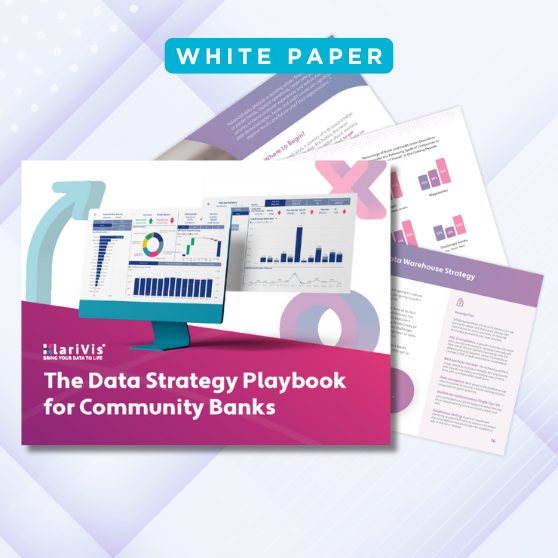The browser you are using is not supported. Please consider using a modern browser.
Article
WEBINAR RECAP: Day in the Life | CFO
Most community bank CFOs start their day the same way: checking multiple systems, pulling overnight reports, and hoping they’ll have answers before the questions start coming. It is a reactive cycle that leaves little time for the strategic work that actually moves the needle.
But what happens when that changes? When a CFO can see their entire operation clearly from the moment they sit down?
Beth Beale, EVP & CFO at Benchmark Community Bank, recently walked through her daily workflow during a KlariVis “Day in the Life” demo webinars, and the difference is striking. It comes down to having the right data at the right moment, presented in a way that enables immediate action.
Morning Clarity: Liquidity That Makes Sense
Beth’s day begins in the Executive Summary dashboard, which provides a full view of overnight activity. She checks liquidity levels, cash balances, and portfolio quality before the day even begins.
“Snapshots are great. Exactly what it says… let’s say we had $7 million in new deposits yesterday through nine accounts. Maybe I need to go look at my depositor list and see where those funds came from.”
This type of visibility provides a competitive advantage. When executives or regulators call with questions, the answers are already at hand. Liquidity management shifts from reactive to proactive, and confidence replaces uncertainty.
Beyond the Spreadsheet Shuffle
Ask any CFO about their biggest frustration and you will likely hear about the endless cycle of manual reporting. Beth explained that before KlariVis, her team was forced to combine queries, custom reports, and multiple spreadsheets.
“What I saw was the ability for that data to be pulled together without me or someone on my team running a bunch of queries, writing a bunch of custom reports, taking five different sources and dumping them into an Excel file… by the time we make a decision, you have to start all over again.”
By shifting to on-demand dashboards like the Executive Daily Impact Report, Beth eliminated that cycle. Reports are no longer built manually, and her team’s time is spent on analysis and strategy rather than formatting spreadsheets.
Margin Management That Moves the Needle
Every community bank CFO knows that net interest margin drives everything. The difference for Beth is how quickly she can act on it.
She reviews Loan Portfolio Detail and Deposit Portfolio Detail dashboards daily, looking at portfolio composition by rate type, interest rate spreads, and maturity schedules. This gives her the ability to identify shifts in yield and adjust pricing strategies immediately.
“Using on-demand insights, we have been able to expand our margin almost 40 basis points by informing our decision-making with real-time data.”
Forty basis points represents the power of small daily adjustments that accumulate into meaningful results. When CFOs can see performance as it develops rather than weeks later, they move from reviewing outcomes to actively shaping them.
Changing Conversations Across the Organization
One of the most visible cultural shifts has been in pricing discussions. Lenders and branch teams now use Rate Insights dashboards to see the financial implications of their requests.
“With something like this, they can see it. So we’re able to inform our employees, and they’re able to better understand why we can’t or shouldn’t cut that loan rate a quarter if we need to compete. Let’s start with ten basis points.”
This visibility builds understanding. Instead of pushing back with “no,” the CFO’s office shows employees the direct margin impact of decisions, creating alignment rather than resistance.
Decisions That Happen in Real Time
The impact of on-demand data becomes most clear in critical meetings. During a credit administration discussion, Beth’s team debated whether to remove risk ratings for certain commercial loans.
Instead of engaging in constant back and forth over the course of a couple of weeks, she instead pulled up the Loan Portfolio Detail dashboard during the meeting. The analysis revealed that nearly 30 percent of their commercial portfolio would be affected — far more than anyone expected. The team made the decision immediately to maintain current risk management standards.
As KlariVis Founder & CEO Kim Snyder reflected: “In my banking days, you had to pull the data, validate it, and schedule another meeting. In this case, the decision happened in the room.”
This is what happens when information moves at the speed of decision-making rather than the speed of spreadsheet creation.
Building Trust Through Consistency
Benchmark rolled out access beyond the finance team to lenders, branch managers, and executives.
Beth explained, “The one version of the truth really was the thing that, from a data management and a data presentation perspective, internally, has been phenomenal for us.”
Even skeptics were convinced. Benchmark’s top commercial lender described it as, “The best thing the bank’s done since I’ve been here.” Let that sink in for a moment.
When everyone works from the same validated dashboards, duplication disappears, conflicting numbers vanish, and trust in the data becomes universal.
Where CFOs See Immediate Impact
These shifts show up quickly in day-to-day execution:
- Liquidity checks take minutes, not hours. Beth uses the Executive Summary each morning to see cash flows and portfolio quality at a glance.
- Margin gains compound daily. Loan and Deposit Portfolio dashboards surface rate shifts early enough to act.
- Risk debates resolve on the spot. Loan Portfolio Detail allows scenario analysis during meetings, avoiding days of back-and-forth.
The difference between good CFOs and great ones often comes down to timing: having the right information at the moment it matters most. When data is available on demand, CFOs not only manage their responsibilities more effectively, they transform how their organizations operate.



